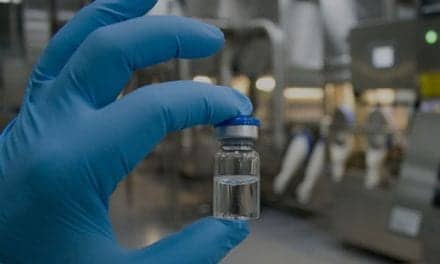There are more than 30 blood tests in clinical practice to confirm many common diseases, but blood tests that detect hearing loss and vertigo are not yet clinically available. On the hunt for promising biomarkers for these diseases is UConn Health physician-scientist, Kourosh Parham, MD, PhD, an associate professor and director of research in the Division of Otolaryngology, Head and Neck Surgery.
Currently, hearing loss can only be diagnosed through hearing tests such as audiograms. There is no way to detect hearing loss at its earliest stages, which leaves patients vulnerable and their doctors frustrated at the limited prevention and intervention options available by the time of diagnosis.
Identifying Blood Biomarkers of Hearing Loss

At UConn Health’s Outpatient Pavilion Dr Parham uses an otomicroscope to examine the ear of a patient. Dr Parham has filed for patents on a blood test that can provide early diagnosis of hearing loss. (Photo: Frank Barton/UConn Health)
Dr Parham has discovered that two recently identified unique inner ear proteins can be detected in minute quantities in the blood, and that their levels correlate with inner ear disorders. These proteins could potentially serve as blood biomarkers to help improve the early detection and diagnosis of hearing loss or vertigo. Dr Parham has developed and patented the first-ever blood tests for these conditions and is currently testing their promise at UConn Health.
In his search for hearing loss blood biomarkers, Dr Parham started with already identified unique inner ear proteins. He identified a promising candidate for a blood biomarker in a protein of the inner ear called prestin. In his studies, he has demonstrated that changes in prestin levels in the blood are linked to hearing loss, even before this loss can measured by audiograms.
Acquired hearing loss is a widespread condition. Nearly 50 million Americans have some type of hearing loss or tinnitus (ringing in the ears) that can affect their daily communication and quality of life. Hearing loss can be inherited, but is most often acquired through acoustic trauma, prolonged exposure to loud noise, or toxicity from medications such as chemotherapy, which lead to damage of cellular components of the inner ear, or cochlea. The cochlea has a series of small fluid-filled canals which contain outer hair cells that manage the cochlea’s ability to tune sound and increase its sensitivity to sound. Outer hair cells are known to show the first damage from excessive noise or toxicity injury.
Dr Parham’s new blood test traces the specific protein prestin that is released by outer hair cells when injured. Prestin is located within the inner cellular membranes of outer hair cells. The simple blood test detects inner ear damage, and also helps quantify the extent of the hearing loss through measurement of the protein’s level in the blood. Parham’s studies have already proven successful in the laboratory, and he is planning to conduct human clinical trials soon.
Identifying Blood Biomarkers of Vertigo
Before uncovering a biomarker for hearing loss, Parham’s research first led him to discover a unique blood biomarker for benign paroxysmal positional vertigo (BPPV), a common condition – particularly in older adults – that can cause severe dizziness due to inner ear abnormalities. While it can strike at any age, BPPV is by far the most common cause of vertigo in the elderly. It is challenging to diagnose, however, and this typically results in delayed diagnosis and costly, unnecessary imaging tests.
Vertigo symptoms can include sudden onset of extreme dizziness that may cause nausea and loss of balance, and lead to falls and bone fractures. It can have a debilitating impact on a person’s daily function and quality of life, with vertigo episodes lasting from two weeks to 6 months. Loose ear crystals, made mostly of calcium carbonite, are the culprit underlying this kind of vertigo, which is triggered by a change in head position. The inner ear has crystals, known as otoconia, that act as gravity detectors to help the human body balance. Normally they don’t move. However, as we age they can become loose, with a simple turn of the head or even when moving to lie down. These motions allow the crystals to enter the inner ear’s sensitive canals. The body’s response to this abnormality leads to the onset of vertigo symptoms.
The inner ear secretes a number of unique proteins including Otolin-1. This protein is only expressed in the inner ear, and is one of the building blocks of inner ear crystals. In findings reported in Otolaryngology-Head and Neck Surgery in 2014, Dr Parham reported that these crystals eventually dissolve and their derivatives are released into the body’s blood stream, where they can be detected. His study showed the presence of Otolin-1 in the blood of all study subjects, but much higher levels in the blood of those with BPPV. According to Parham, improved tools to diagnose BPPV in a timely fashion can be followed with maneuvers to guide loose crystals back into place and relieve the dizziness. There are currently no medications to treat vertigo, only medications that can suppress the symptoms.
Dr Parham hopes that his research into these biomarkers and the blood tests he has developed will establish new clinical norms for detecting early hearing loss, vertigo, and other inner ear disorders. “Early identification of at-risk people will allow for intervention before disabling hearing loss develops,” he says, “and hopefully reduce other health complications and financial burdens linked to these inner ear conditions. Our rationale was if a simple blood test can help hunt down this one biomarker for vertigo, then it could most likely also help track down a few others.”
Dr Parham has filed a patent for the biomarker blood tests he developed in his lab at UConn Health. To help primary care and emergency room physicians better recognize vertigo and care for patients, he recently published patient care recommendations in the Journal of the American Geriatrics Society with Dr George Kuchel of the UConn Center on Aging.
Source: UConn Health
Image credits: Frank Barton/UConn Health; © Angellodeco | Dreamstime.com





